Community Description: Los Angeles
- As of 2018, the number of residents exceeded 3.990.000 people, demonstrating a steady population growth pattern. Starting from 2010, the annual population growth rate varied from 0.2% to 0.8% (World Population Review, n.d.).
- The City of Los Angeles is located near the San Gabriel mountain range and is bounded by it and the Pacific Ocean. The land area that it takes exceeds 1213km2, whereas the water area is 88km2 (WPR, n.d.).
- Los Angeles presents a cultural center of Southern California and the largest city of the County of Los Angeles. The community is located in the most populous county and the second largest metropolitan region of the United States (WPR, n.d.).
- In 2017, the average yearly earnings were $35.390 for males and $30.400 for females and depended on the educational level, whereas mean household incomes varied from $60.000 to $121.000. The Los Angeles metropolitan area has the second largest nominal GDP in the U.S. – 1.043.700 million dollars (WPR, n.d.).
- The population includes 19.5% of school graduates, 21.7% of people with bachelor’s degrees, 17.8% of college graduates, and 11.3% of citizens with graduate degrees. About 21% of people have not graduated from high school.
- The city ranks high in ethnic diversity, but it is still considered as white-dominated. The major ethnic groups include Caucasians (52.2%), Asians (11.6%), African Americans (8.9%), people of mixed-race origin (3.5%), and American Indians (0.7%). Almost 23% of residents identify themselves as the members of “some other race” as a protest against the existing ethnic classification.
- Concerning phenomenology, the city is ethnically, linguistically, and culturally diverse. Economic inequality that depends on race also contributes to a cultural divide.
- Interactions: well-developed transportation system, a strong infrastructure, and people’s access to natural resources and means of communication (WPR, n.d.).
- At the governmental level, the goals include improving citizens’ quality of life, eliminating poverty, and implementing up-to-date approaches to construction; given the mentioned diversity, personal goals vary greatly.
- Interests: maintaining financial leadership and dominant positions in the film and entertainment industries.
- Barriers/challenges: environmental issues (more specifically, air pollution), gender and race-related wage gaps, communicable diseases, drug abuse (Garcia-Gonzales, Shamasunder, & Jerrett, 2019; WPR, n.d.).
- SDOH: race-based poverty – the poverty rate is 25-27% in Hispanics and African Americans, but it does not exceed 12% in Caucasians. Access to jobs varies based on ethnicity and education level, whereas social isolation and homelessness affect health outcomes (more than 70% of homeless people are unsheltered) (Los Angeles City Health Commission, 2017).
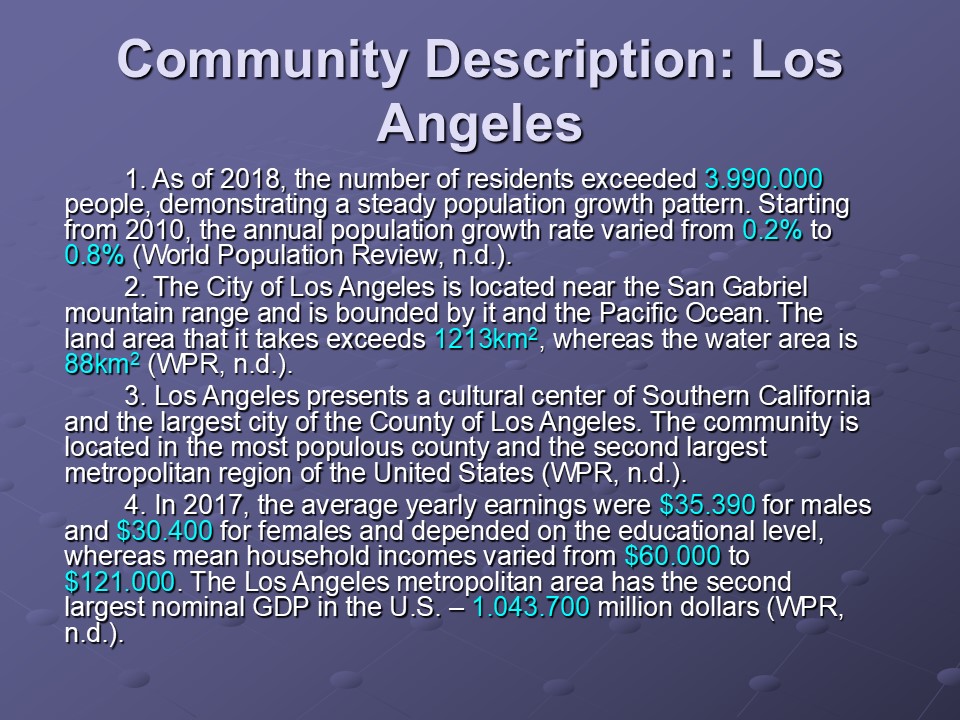
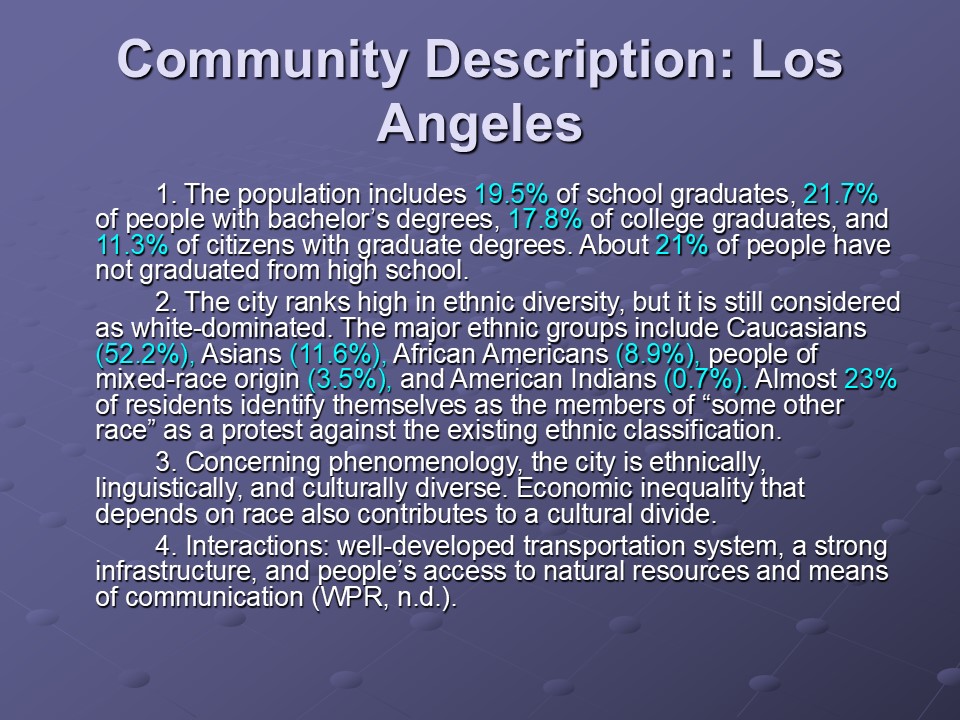

Functional Health Patterns: Values/Beliefs
- Funding sources: no external funding;
- Partnerships: community health nurses, the community’s authorities, and the health department (information sources).
- Caucasians, the predominant group, do not share beliefs concerning the effectiveness of alternative treatment (WPR, n.d.).
- Christian beliefs impact people’s dietary habits and attitudes toward family celebrations.
- Resources: chapels, churches, Islamic centers, support groups, group therapy events, etc.
- People’s attitudes toward health promotion are evident from their active social participation (Health & Wellness Funfest, volunteering, etc.) (LACHC, 2017).
- There are protest movements, so the community values a proactive approach to life, justice, and democracy (March & Rally Los Angeles, n.d.).
- Large expenditures: housing, transportation, and alimentary products; the adequacy of funds depends on education and access to jobs (Bureau of Labor Statistics, 2018).

Health Perception/Management
- Actual and at-risk diagnoses: prediabetes in 39.7% of adult Los Angeles residents and 33.9% of the U.S. population (Centers for Disease Control and Prevention, 2018; Hales, Carroll, Kuo, & Simon, 2019).
- Recommendations: in some schools, due to caregivers’ personal beliefs, vaccination rates do not exceed 30-40%, which involves potential threats (Khazan, 2014).
- The state with the second lowest death rate (618/100.000 people in 2017); the leading causes of death are cancer, heart disease, and Alzheimer’s (Los Angeles Almanac, n.d.).
- Prevention programs (lead poisoning, childhood asthma, HIV/STI, adolescent pregnancy) are considered sufficient. A large number of specialty doctors, GPs, and mental health professionals offer their services. Common referrals to health resources, including Women’s Health Services, Christian Health Centers, and UCLA Medical Center; services are used by more than 80% of residents with insurance (LACHC, 2017).
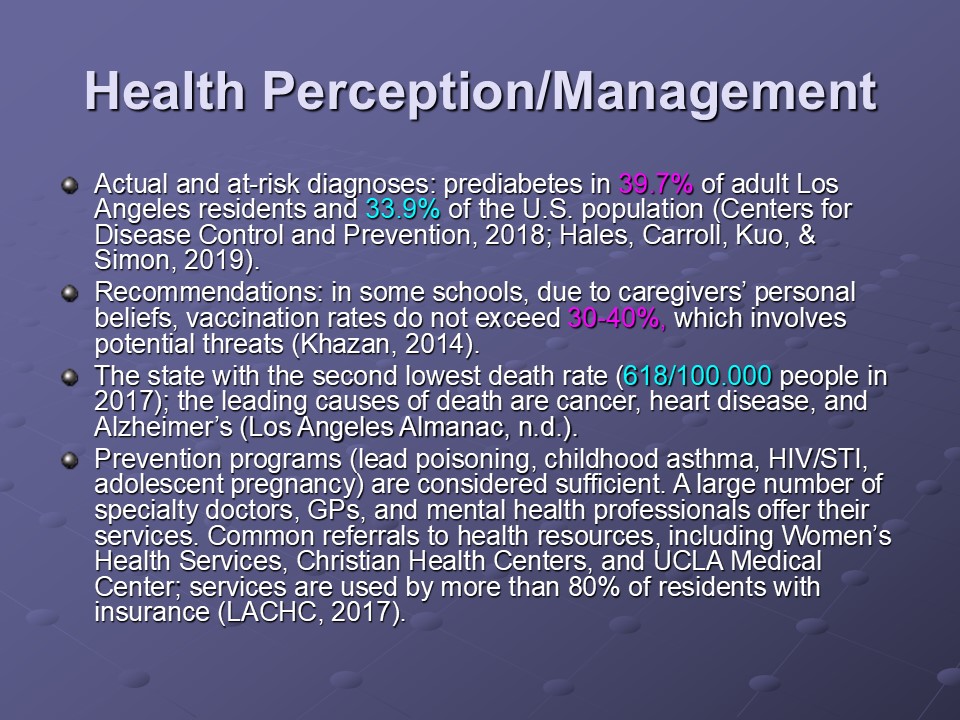
Nutrition/Metabolic
- Poverty rates contribute to nutrient deficiencies, but adult obesity rates in the county are lower than the national average (21% and 39% in 2015) (CDC, 2017).
- According to LACHC (2017), food insecurity rates are still high among homeless citizens, but food stamp programs are in use.
- A number of drinking fountains in parks have been removed recently, leading to increased risks of dehydration among the homeless (LACHC, 2017).
- Fast and junk food is easy to access, and the most popular restaurant chains are widely represented.
- Unhealthy food consumption: long queues in fast-food restaurants, child obesity.
- Based on observations, the nutritional content of food sold in educational institutions aligns with California’s Nutrition Standards (no unhealthy high-fat foods).
- Between 70% and 80% of students are eligible for federally reimbursable meals (Education Data, n.d.).
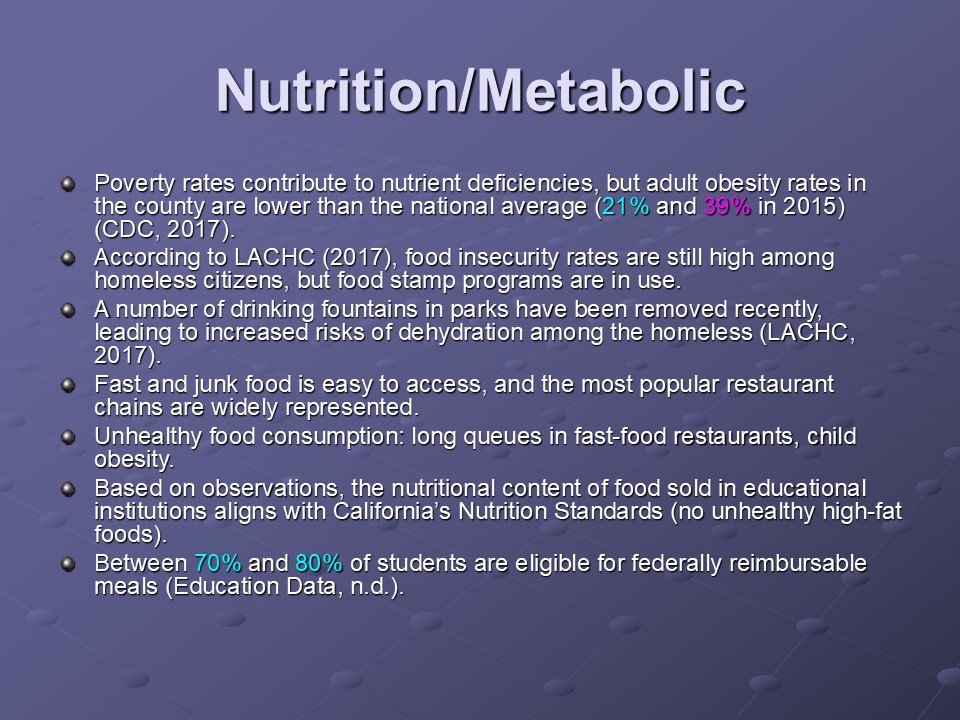
Elimination
- Particulate matter, carbon monoxide, and lead are commonly associated with respiratory disease and poor air quality (Shirmohammadi et al., 2017).
- Proper waste disposal; noise levels vary but are within the normal range.
- There are official pest control initiatives and proper community notifications.
- Laundry services are accessible and affordable, and there are enough bathrooms with hygiene supplies in public places that are cleaned 3-4 times a day.
- Health providers use universal precautions (hand hygiene, protective clothing, cleaning) according to job instructions; teachers and members do it in case of obvious risks.
- Air conditioners, heater systems, and fire safety measures are used for temperature control.
- Security guards in public places, video surveillance, and badge access control systems help to ensure safety.

Activity/Exercise
- Private and public gyms in all neighborhoods are supplied with equipment for cardiovascular exercise and weight routine, and some of them offer discounts.
- There are playgrounds, swimming pools, and ice rinks with large flows of visitors. Safety training programs based on regulations are implemented by the police, emergency agencies (Safe House, Emergency Planning, etc.), or athletic trainers in gyms.
- Traumas related to car accidents or occupational injuries are common (Citywide Law Group, n.d.). Rail transport, cars, bikes, and bicycles are popular transportation options.
- Many people are active users of the Internet, but the amount of time spent on leisure activities varies between households.
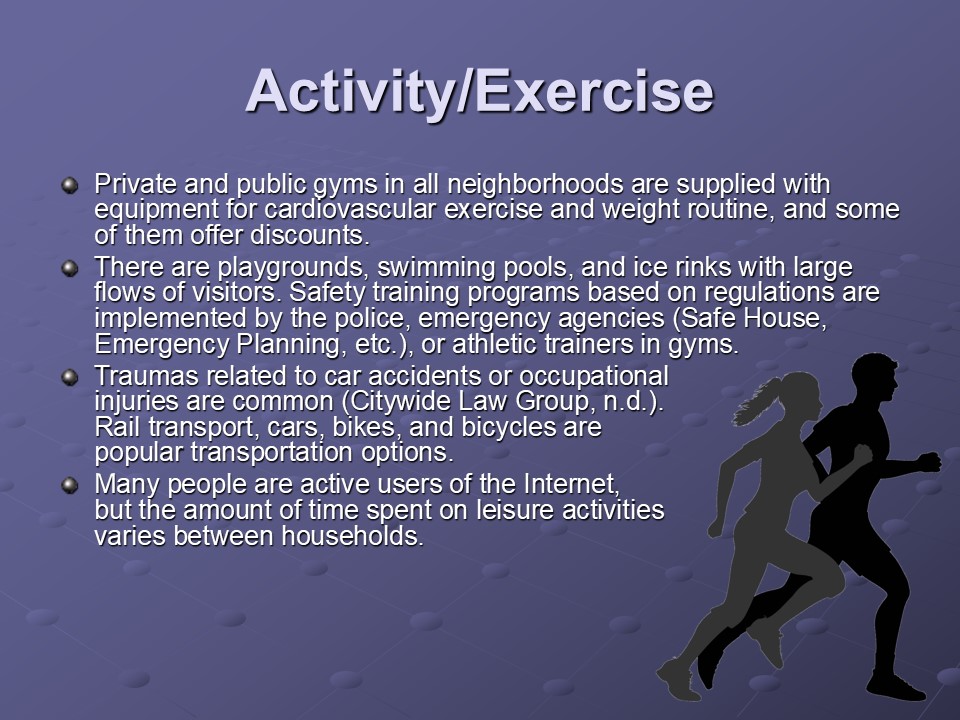
Sleep/Rest
- In dormitory districts, there are sleep routines that meet the NIH sleep hour standards (7-8 hours for adults and 9-10 for teenagers and children) (Bravata et al., 2018). With reservation of days that are national holidays, it is quiet from 9 p.m. to 8 a.m.
- Indicators: no construction works during sleep hours, community members are active during the daytime, playgrounds or teenagers and children are almost never empty.
- The majority of citizens are in the workplace from 8-9 a.m. to 4-5 p.m., but those in the entertainment sector may work night shifts. The recommended noise levels for the residential areas are strictly observed, and street lights are not too intense to affect people’s recreation and proper sleep. Except for entertainment places, the levels of crowding are quite low during nighttime.
- Few people use drugs, but some citizens can be observed smoking or consuming alcoholic beverages in bars or at home (California Health Care Foundation, 2018). Also, caffeine consumption is quite high in full-time office workers and students who combine studies, extracurricular activities, and side jobs. People’s health may be affected by sleep-wake cycle irregularities or difficulty falling asleep.

Cognitive/Perceptual
- The population speaks more than 200 languages, but English and Spanish are used most often (WPR, n.d.). English is understood by the majority of people, but minor communication barriers may exist.
- About 86% of people in the city of L.A. are school graduates compared to the national average of 87.3% (U.S. Census Bureau, n.d.; WPR, n.d.).
- Abundant opportunities (schools, on-the-job training in more than twenty industries, GED preparation classes, etc.) (WPR, n.d.).
- State and federal mandates for English learners and opportunities for continuing education (California Department of Education, n.d.).
- Special education centers for children with physical/mental disabilities, academies for gifted students (Oak Crest, etc.). Universities and schools are equipped with computers and provide access to both physical and digital libraries.
- There are tuition reimbursement and scholarship programs for both citizens and immigrants.
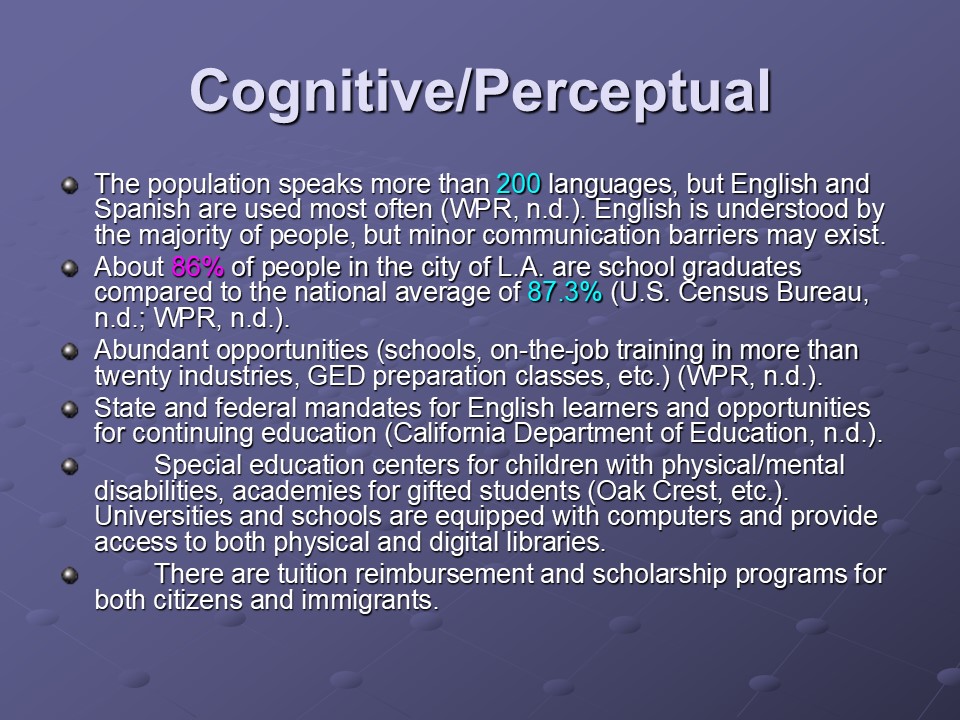
Self-Perception
- Concerning age levels, the most numerous groups are men and women aged 25-35 (WPR, n.d.).
- Community improvement programs (cultural diversity, community alert, etc.) are offered by Community Build, Inc. and the state authorities.
- Initially, the city’s area was inhabited by American Indian tribes. In 1781, fourteen families of different descent established a new farming area that grew into the city (The City of Los Angeles, n.d.). The intersection of cultures that contributed to the community’s development is still reflected in the city’s ethnic diversity.
- Pride is evident from the popularity of exercising, the use of medical/mental health services, and the presence of daily routines.
- Published descriptions of the selected community can be found in electronic and printed encyclopedias, travel guides, and online (The City of Los Angeles, n.d.; WPR, n.d.).
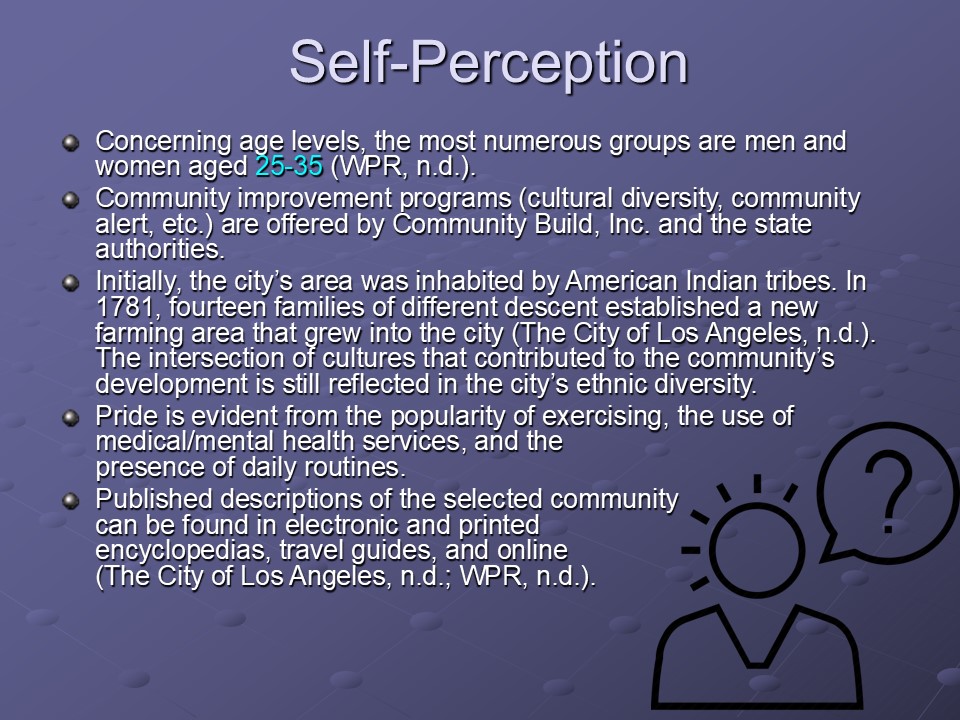
Role/Relationship
- Community members interact in a friendly and open manner despite cultural differences.
- Low-income families and people with disabilities are vulnerable due to the lack of economic power, and it restricts the range of treatment options available to them.
- Church leaders, city officials, and the California State PTA hold power by managing resources needed for goal accomplishment and positively influence the community.
- Sexual harassment, as well as discrimination on the basis of age, disability, ethnicity, and gender identity is prohibited (California Department of Fair Employment and Housing, n.d.).
- The city’s police stations collaborate with the L.A. County Sheriff’s Department. The fire authorities’ response times are 6 minutes 40 seconds (EMS) and 6 minutes 20 seconds (non-EMS alarms) (Los Angeles Fire Department, n.d.). The city has its own food/blood banks and collaborates with the broader community.

Sexuality/Reproductive
- Sexual behaviors vary depending on the culture, but education related to STDs and safe sex is offered by the health authorities (Planned Parenthood L.A., etc.).
- Birth control tools (condoms, antifertility agents, etc.) are accessible, but not all products are sold without medical prescriptions. The birth rate is now 56 per 1000 women from 15 to 44 years old, abortion/miscarriage rates have also declined recently (March of Dimes, 2019).
- Citizens have access to pregnancy clinics, numerous support groups for new moms, and maternity/paternity leaves.
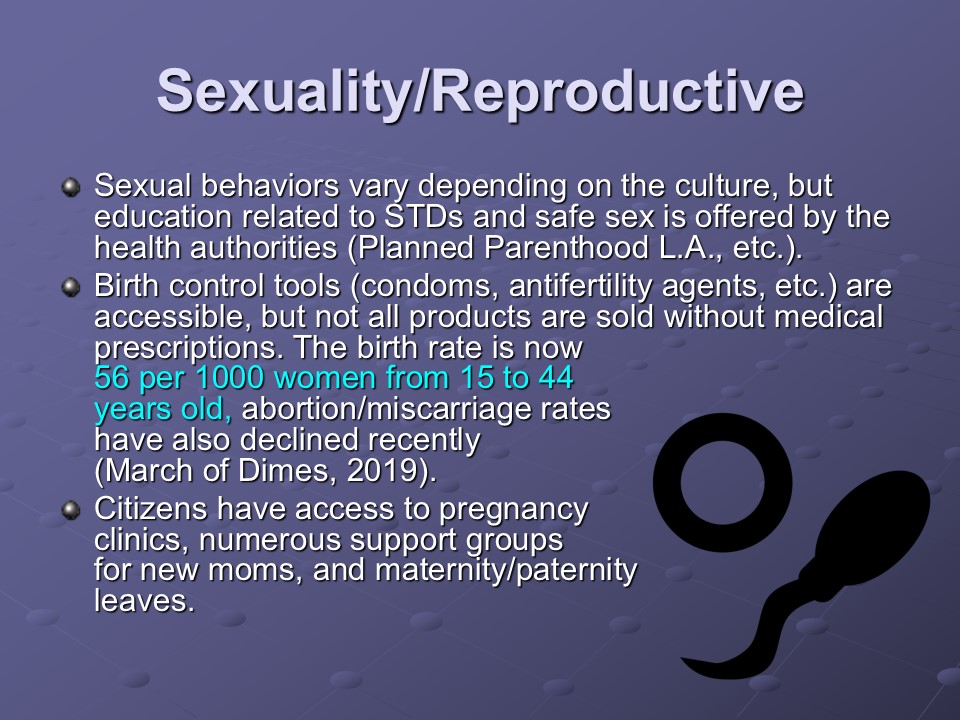
Coping/Stress
- There are some reductions in violence/crime issues, but poverty rates still exceed 25% among racial minorities (WPR, n.d.).
- About 17 CPS referrals daily, with general neglect and abuse by siblings as the most common causes (Kids Data, n.d.).
- 2002-2016: alcohol and drug abuse rates have grown by 2-3% (CHCF, 2018).
- Crowding and poverty as stressors; multiple support groups, psychology hotlines, and specialists in psychology, psychiatry, and psychotherapy help to deal with mental health issues.
- Past disasters: large fires, earthquakes, and floods; regular fire drills (2-4 times per year depending on the level of threat) are used to ensure workplace safety.
- The emergency management committee (city authorities, emergency services, etc.) plays essential roles in response planning, organization, and development of crisis intervention plans/policies.
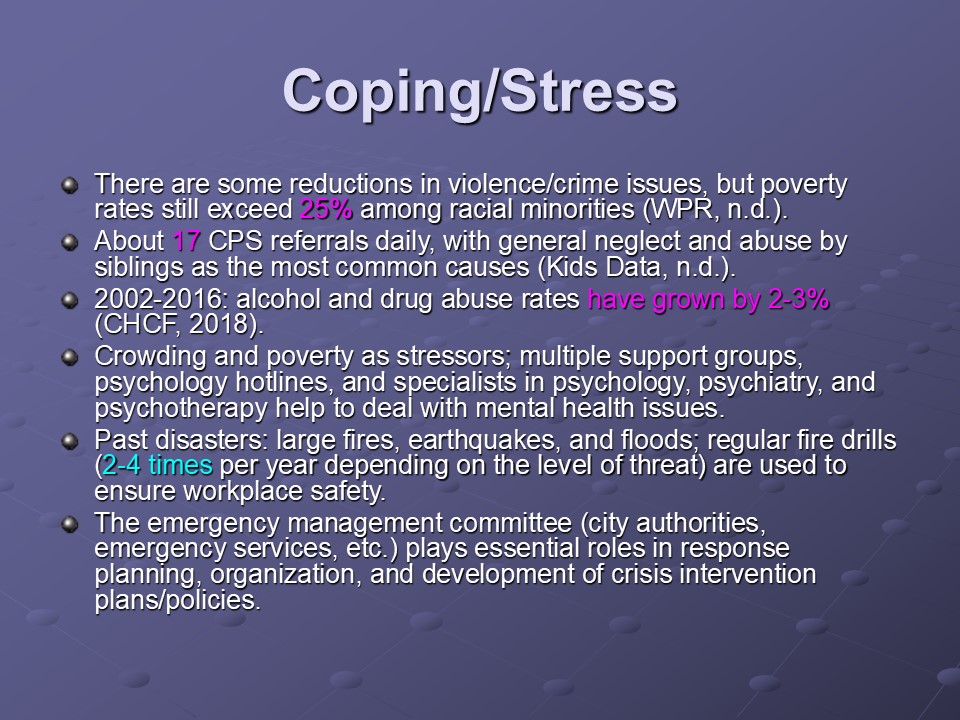
Interview Summary (D., 35 Years Old, a Community Health Nurse)
Do you feel valued as a specialist when working with L.A. residents? Why or why not?
D. works in a hospital in L.A. and helps clients from different age groups. Despite her patients’ varying educational levels and approaches to communication, she rarely sees conflicts between providers and clients. The majority of L.A. residents are conscious of their condition and education that she provides, which makes her feel valued.
In your opinion, are there specific physical/mental health issues common in L.A.? If so, what surveillance/prevention measures require special consideration?
D. expresses concerns about some mental health issues, including depression in adults and adolescents, suicidal ideations, anxiety, and BDD in women. In reference to physical issues, she emphasizes diabetes, influenza, and STIs. She lists a range of preventive measures, including sex education in schools, school-based mental health interventions, and immunization awareness events.
As a community health nurse, how would you characterize your role in maintaining L.A. residents’ overall health?
The role is described with attention to the following themes: interdisciplinary collaboration, health advocacy, and patient education.
Are there specific communication difficulties linked to local people’s mentality?
D. mentions some clients’ overconfidence in making important health decisions.
If you communicate with NPs from other regions, are your experiences with patients different? Why or why not?
The interviewee has friends who work as nurses in other states, primarily in rural areas. Based on her assumptions, people in L. A. are more educated and more sensitive to patient rights compared to her friends’ clients.

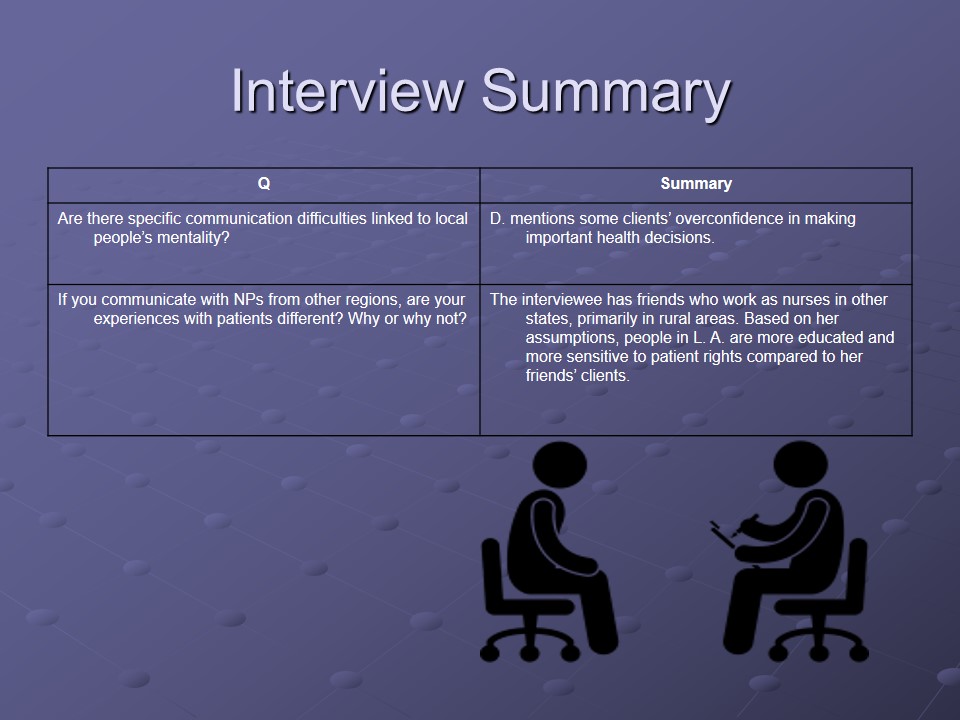
Issues/Health Promotion Opportunities
Based on the assessment results, health promotion efforts related to the following topics are recommended:
- Prevention of prediabetes, diabetes, and childhood obesity (weight control, exercising, nutritional habits, age-appropriate activity, sleep hygiene, etc.);
- Childhood immunizations (parent education, handout materials, parent-nurse collaboration, and vaccination awareness campaigns).
- Drug/alcohol abuse (school-based education, access to jobs, hobby clubs/sports participation, and awareness events).

Conclusion
- Overall, people in Los Angeles have numerous educational, job, and health promotion opportunities, which contributes to people’s good physical and mental health.
- Particular problems include the prevalence of prediabetes and obesity in different age groups, as well as poor compliance with immunization recommendations and drug/alcohol use.
- Taking these findings and the interview summary into account, it is recommended to implement additional measures to promote healthy lifestyle behaviors and increase parents’ awareness of the benefits of timely immunization.
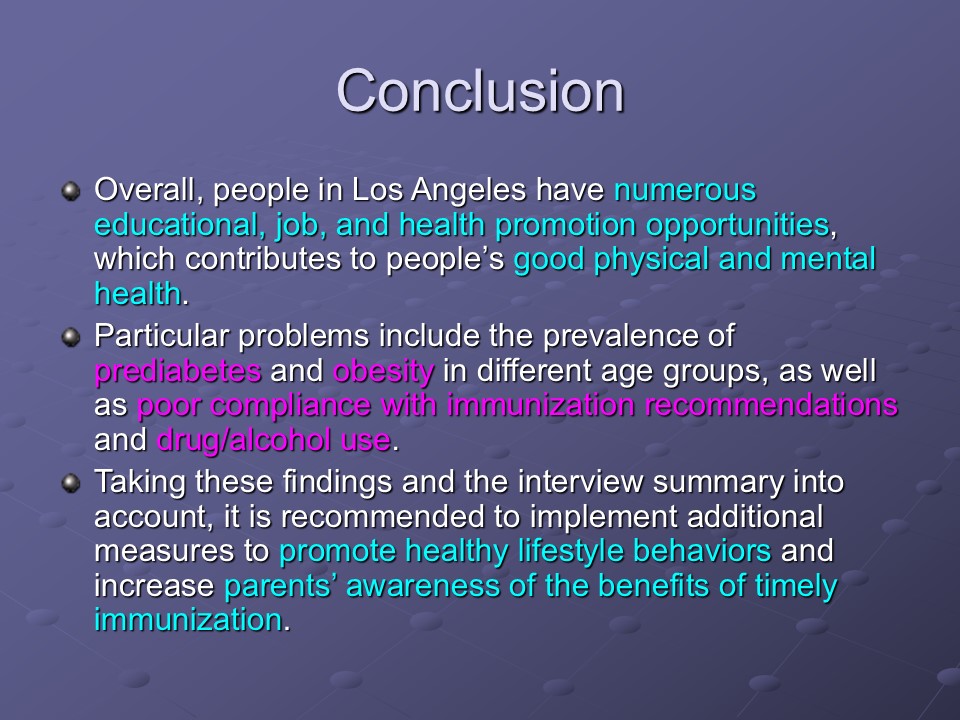
References
Bravata, D. M., Sico, J., Vaz Fragoso, C. A., Miech, E. J., Matthias, M. S., Lampert, R., … Tobias, L. (2018). Diagnosing and treating sleep apnea in patients with acute cerebrovascular disease. Journal of the American Heart Association, 7(16), e008841.
Bureau of Labor Statistics. (2018). Consumer expenditures for the Los Angeles area: 2016-17. Web.
California Department of Education. (n.d.). English learners. Web.
California Department of Fair Employment and Housing. (n.d.). Employees and job applicants are protected from bias. Web.
California Health Care Foundation. (2018). California health care almanac. Substance use in California: A look at addiction and treatment. Web.
Centers for Disease Control and Prevention. (2017). Prevalence of obesity among adults and youth: United States, 2015–2016. Web.
Centers for Disease Control and Prevention. (2018). Prevalence of prediabetes. Web.
City of Los Angeles. (n.d.). The history of Los Angeles. Web.
Citywide Law Group. (n.d.). Los Angeles car accident statistics. Web.
Education Data. (n.d.). Los Angeles County Office of Education. Web.
Garcia-Gonzales, D. A., Shamasunder, B., & Jerrett, M. (2019). Distance decay gradients in hazardous air pollution concentrations around oil and natural gas facilities in the city of Los Angeles: A pilot study. Environmental Research, 173, 232-236.
Hales, C. M., Carroll, M. D., Kuo, T., & Simon, P. A. (2019). Diabetes and prediabetes among adults in Los Angeles County and the United States, 1999–2006 and 2007–2014. National Health Statistics Reports, 23, 1-7.
Khazan, O. (2014). Wealthy L.A. schools’ vaccination rates are as low as South Sudan’s. The Atlantic. Web.
Kids Data. (n.d.). Reports of child abuse and neglect, by type of abuse. Web.
Los Angeles Almanac. (n.d.). Deaths and death rates Los Angeles County. Web.
Los Angeles City Health Commission. (2017). Health commission report 2015-16. Web.
Los Angeles Fire Department. (n.d.). Welcome to the Los Angeles Fire Department. Web.
March & Rally Los Angeles. (n.d.). Get involved! Web.
March of Dimes. (2019). Quick facts: Births. Web.
Shirmohammadi, F., Sowlat, M. H., Hasheminassab, S., Saffari, A., Ban-Weiss, G., & Sioutas, C. (2017). Emission rates of particle number, mass and black carbon by the Los Angeles International Airport (LAX) and its impact on air quality in Los Angeles. Atmospheric Environment, 151, 82-93.
U.S. Census Bureau. (n.d.). Educational attainment: Percent high school graduate or higher. Web.
World Population Review. (n.d.). Los Angeles, California population 2019. Web.